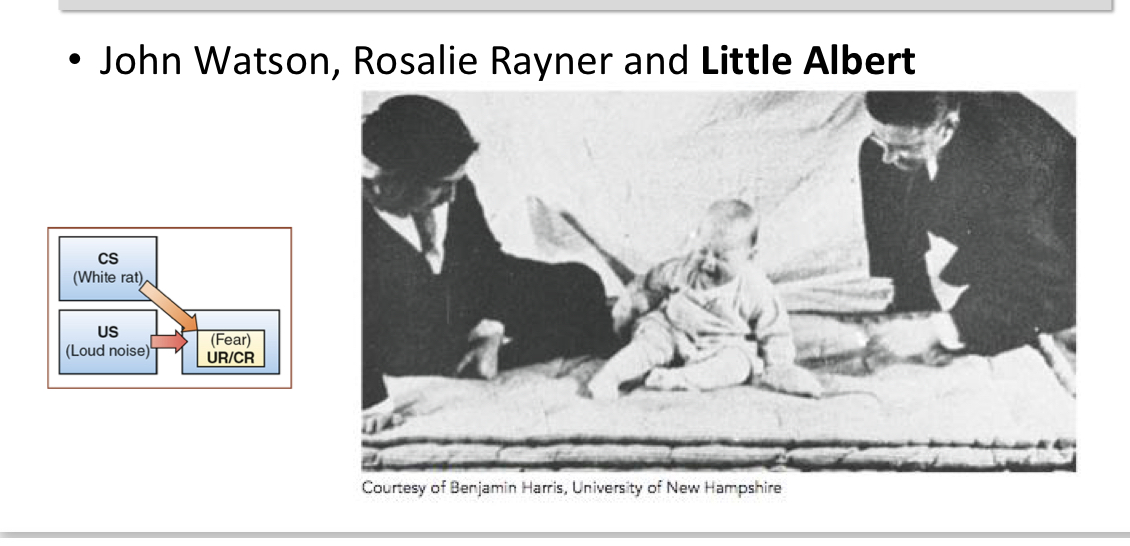psych MT2
1/133
There's no tags or description
Looks like no tags are added yet.
Name | Mastery | Learn | Test | Matching | Spaced |
|---|
No study sessions yet.
134 Terms
Sensation
act of using our sensory systems to detect environmental stimuli
– What stimuli can our body detect? And how?
Perception
the conscious recognition and identification of a sensory stimulus
– How does our brain make sense of the information our sense have detected?
Sensation and perception types
Both sensation and perception are critical for our interpretation and interaction with our environment
She Always Orders Giant Starbucks
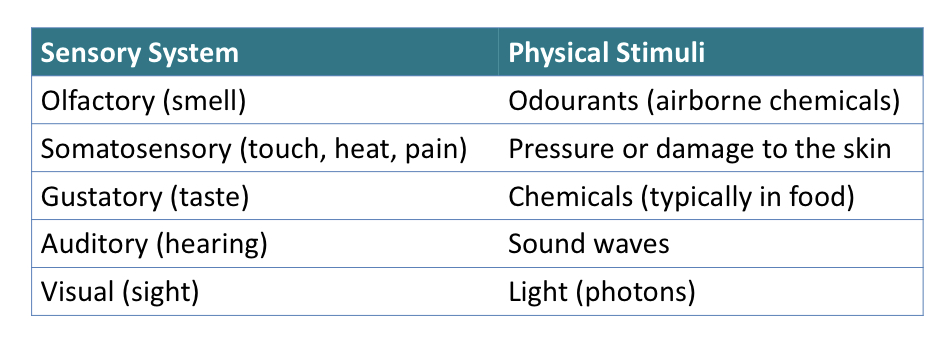
sensory receptors cells
specialized cells that convert a specific form of environmental stimuli into neural impulses
Sensory transduction
process of converting a specific form of environmental stimuli into a neural impulse that our brain can read
Thresholds for senses
Our senses require a certain amount or level of sensory input to detect things
Absolute sense thresholds for most people
the smallest amount of a stimulus that one [most people] can detect:
– Smell – a drop of perfume diffused throughout a six-room apartment
– Taste – 5 millilitres of sugar in 9 litres of water
– Touch – an insect’s wing falling on your cheek from a height of about a centimetre
– Hearing – the tick of a watch at 6 metres in a quiet room
– Sight – a candle flame 50 kilometres away on a clear, dark night
Difference threshold (just noticeable difference)
minimal difference needed to notice a difference between two stimuli
Sensory sensitivity dependence
depends on Experience, expectations, and consequences for failure
Signal detection theory
the response to a signal in every situation depends on an individual’s ability to differentiate between the signal and noise, and on their response criteria
Sensory adaptation
Repeated stimulation of a sensory cell leads to a reduced response.
• Examples:
– The tag in your shirt that bothered you this morning, but now you don’t even notice it!
– The sound of the train that passes by your home several times a day, which you no longer notice.
Bottom up processing (what is it and process)
perception that proceeds by transducing environmental stimuli into neural impulses that move successively into more complex brain regions
Process
Physical stimuli from the environment → neural impulses sent
to CNS→perception
Ex: You take thousands of individual data points of visual stimuli and put them together to create an image of your mother; this is what happens in your digital camera
Top down processing (what it is and process)
perception processes led by cognitive processes, such as memory or expectations
Process:
Previously acquired knowledge → perception
Perception typically involves both types of processing – E.g. recognizing objects/songs/faces/etc.
Ex: You recognize data points and immediately match them to your previous knowledge about something, like your mother’s face
Perceptual set
the readiness to interpret a certain stimulus in a certain way
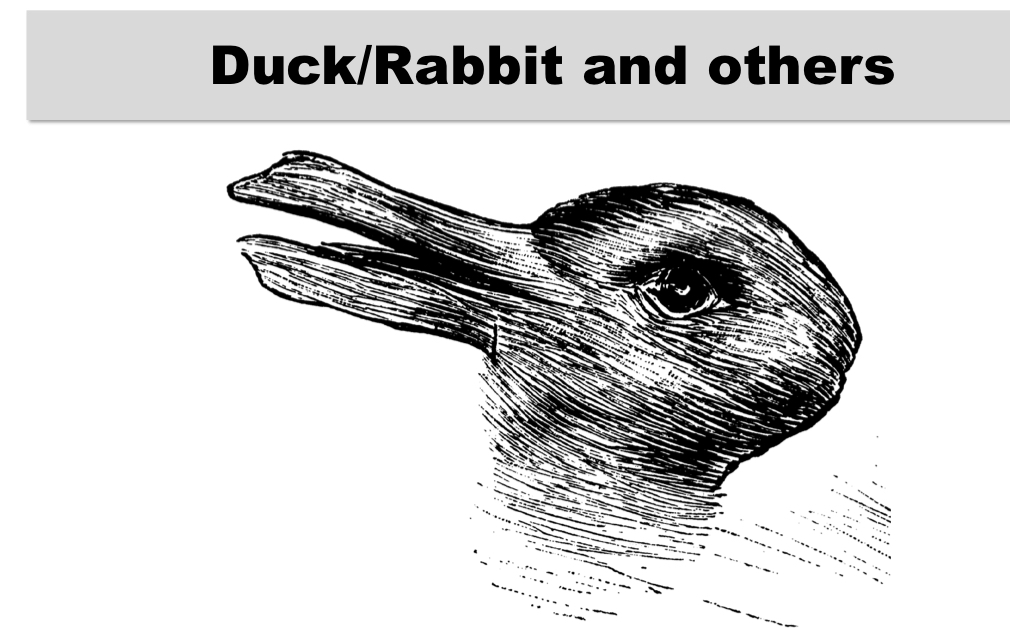
The senses (name them)
nervous system is composed of different sensory systems that detect different kinds of stimuli to transduce into neural impulses
• Commonly understood to be 5 senses (smell, taste, touch, sound, sight)
• But there are more!
– Kinesthetic (body’s movement, posture)
– Vestibular (head’s position and movement)
– ”Touch” is sometimes further divided into Thermoception (temperature detection) and Nociception (pain detection)
Chemical senses
Smell and Taste
– Olfactory sense (smell)
– Gustatory sense (taste)
– Sensory receptors designed to detect chemicals
Odourants (chemical sense:smell)
airborne chemicals that are detected as odours
Olfactory receptor neurons (Chemical senses: smell)
sensory receptor cells that convert chemical signals from odourants into neural impulses that travel to the brain
– These neural impulses also reach amygdala and hippocampus

papillae (chemical sense: taste)
bumps on the tongue that contain clumps of taste buds
Taste buds (chemical sense: taste)
clusters of sensory receptor cells that convert chemical signals from food into neural impulses that travel to the brain
5 taste receptors on tongue (chemical sense: taste)
Five taste receptors on your tongue:
1. Sweet
2. Sour
3. Bitter
4. Salt
5. Umami – the taste of monosodium glutamate (MSG)
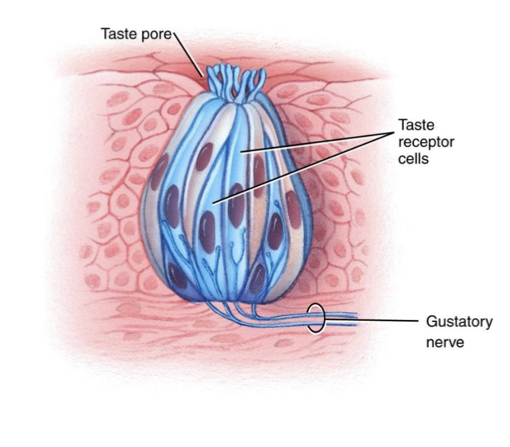
What are the other sensations that are activated when eating
Overall sensations from eating are based on more than smell and taste.
• Consistency of food is relayed to the brain by inputs from touch receptors located on the tongue.
• Some foods are rejected due to texture.
The development of smell and taste
Smell is relatively well-developed at birth. Newborns can show a preference for the odour of their mother’s milk.
• Taste is also well developed at birth. Infants show a preference for sweet and an aversion to bitter.
• Why might infants begin life with these senses well- developed?
What are the individual differences in taste and smell
Females are generally more sensitive to odours than males.
• Taste is variable in individuals; some are more sensitive to bitter substances than others.
– E.g. “super-tasters”
Smell and taste disorders (5)
All Angry Hippos Really Munch
Ageusia – inability to taste, a rare disorder
• Anosmia – inability to detect odours
• Hyposmia – reduced ability to smell
• Reflex epilepsy – a seizure occurs only after exposure to a specific odour
• Migraine headaches – specific odours can trigger migraines
• Disorders may implicate dysfunction in the brain, sensory receptors, or both
Tactile or cutaneous senses (5)
The tactile or somatosensory system is a combination of skin senses, including:
• Pressure
• Touch
• Temperature
• Vibration
• Pain
The tactile senses rely on a variety of receptors located in different parts of the skin.
free nerve endings (somatosensory receptors)
Located near the surface of the skin
– Function: detect touch, pressure, pain, and temperature
Meissner’s corpuscles (somatosensory receptor)
Located in fingertips, lips, and palms (hairless skin
areas)
– Function: transduce information about sensitive touch
Merkel’s discs (somatosensory receptor)
– Located near the surface of the skin
– Function: transduce information about light to moderate pressure against the skin
Ruffini’s end-organs (somatosensory receptor)
– Located deep in the skin
– Function: register heavy pressure and movement of the joints
Pacinian corpuscles (somatosensory receptor)
Located deep in the skin
– Function: respond to vibrations and heavy pressure
The 5 somatosensory receptors
Mean Monkeys Really Punch Funny Hairlines
Pain and temperature
free nerve endings (sharp pain and dull pain)
Free nerve endings for temperature ( hot or cold)
Fine touch and pressure
Meissner’s corpuscle (Touch)
Merkel’s disc (light to moderate pressure against skin)
Ruffini’s end-organ (heavy pressure and joint movements)
Hair receptors (flutter or steady skin indentation)
Pacinian corpuscle(vibrating and heavy pressure)
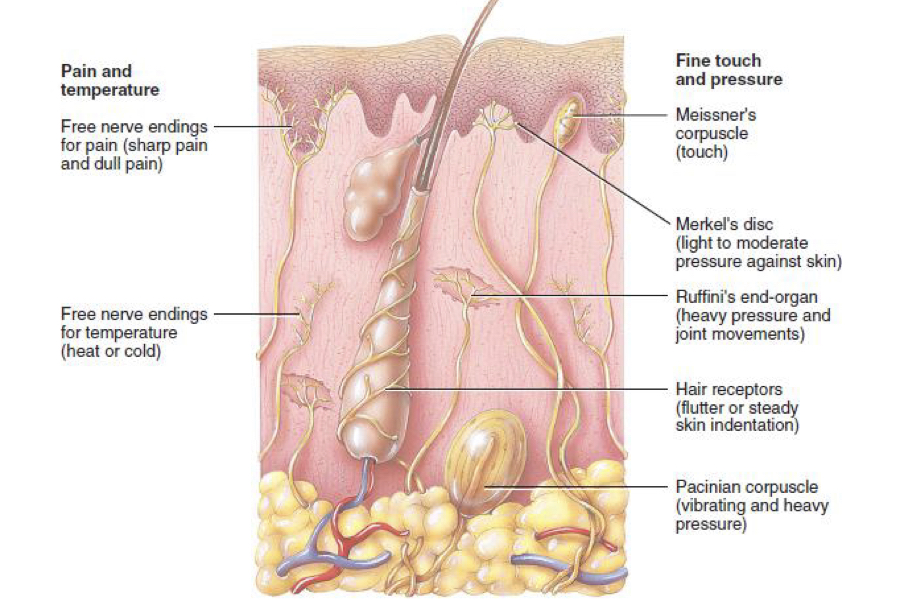
Steps to perceiving touch
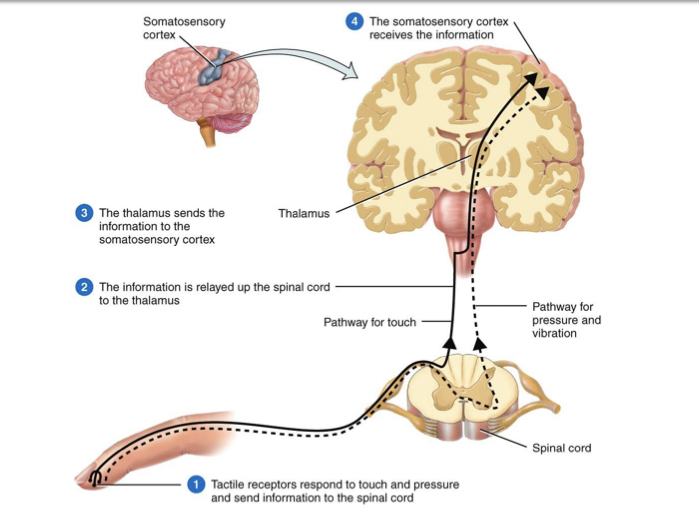
2 pathways of pain
• Fast pathway (myelinated pathway) – sharp, localized pain is felt quicker because it travels along myelinated neurons to the brain
• Slow pathway (unmyelinated pathway) – these inputs communicate with brain regions involved in processing emotions; pain we perceive via the slow pathway is more often burning pain than sharp pain
Development of tactile senses
• Developed at birth.
• After birth, the ability to respond to different somatosensory stimuli is dependent on brain development and learning.
• The work of Harry Harlow demonstrated that touch is necessary for healthy development.
Tactile senses: individual differences (pain)
• Women have a lower threshold for detecting pain than men, which may be due to differences in the nervous system.
• Neuroimaging studies have revealed that people’s brains react differently depending on their sensitivity to pain.
Chronic pain and what are some chemicals that can alleviate this pain (disorder of tactile senses)
• Chronic pain is the most common abnormality associated with the somatosensory system.
o Endorphins and enkephalins are naturally occurring chemicals produced by the nervous system that have pain-relieving properties
o Opiates such as morphine, heroin, and oxycodone mimic the body’s pain relief system
o Gate control theory and touch sensations can help alleviate acute pain.
No pain( disorder of tactile senses)
No pain (familial dysautonomia) – rare genetic condition associated with an inability to detect pain or temperature and produce tears.
Phantom limb sensations (disorder of tactile senses)
Phantom limb sensations – tactile hallucinations of touch, pressure, vibration, and pain in the body part that no longer exists.
sound waves (auditory sense: hearing)
vibrations of the air in the frequency of hearing.
Frequency (auditory sense: hearing)
• Frequency – the number of cycles per second in a wave
– Determines pitch of sound
– Measured in units called Hertz (Hz), which represent cycles per second
– We hear best in the range of 2000 − 5000 Hz
Amplitude (auditory sense:hearing)
• Amplitude – the magnitude (height of a wave) – Determines loudness
– Measured in units called decibels (dB)
How the ear hears (sound waves to middle ear)
• Sound waves enter the outer ear
• Waves hit the tympanic membrane (eardrum)
• Waves pass into the middle ear, which contains the three smallest bones in the human body: the ossicles: maleus (hammer), incus (anvil), and stapes (stirrup)
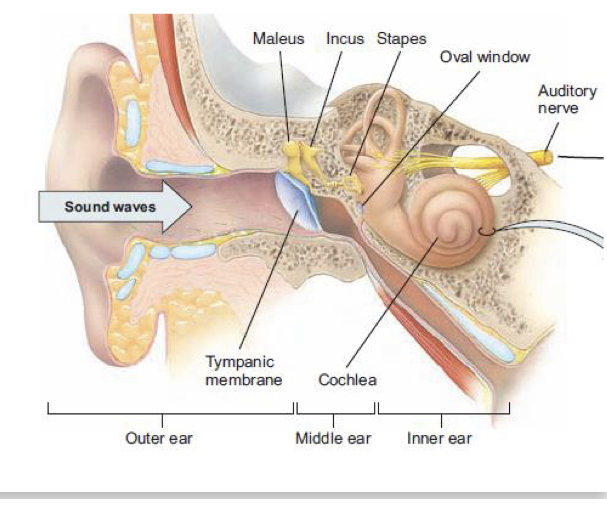
How the ear hears (middle ear to impulses to brain)
• Stapes hits the oval window, causing a wave to form in the fluid in the cochlea
• The fluid deflects the basilar membrane, bending its hair cells that transduce the fluid sound wave into electrical activity
• As hair cells move, neural impulses are created and sent to the brain

Overall how sound enters the ear
• Sound waves enter the outer ear
• Waves hit the tympanic membrane (eardrum)
• Waves pass into the middle ear, which contains the three smallest bones in the human body: the ossicles: maleus (hammer), incus (anvil), and stapes (stirrup)
• Stapes hits the oval window, causing a wave to form in the fluid in the cochlea
• The fluid deflects the basilar membrane, bending its hair cells that transduce the fluid sound wave into electrical activity
• As hair cells move, neural impulses are created and sent to the brain

Tonotopic map
o Sound travels to the brainstem, the thalamus and then the auditory cortex
o In the auditory cortex, sound is received in a tonotopic map meaning the sound activates specific spots on the brain
o Certain frequencies are always received by specific areas of auditory cortex
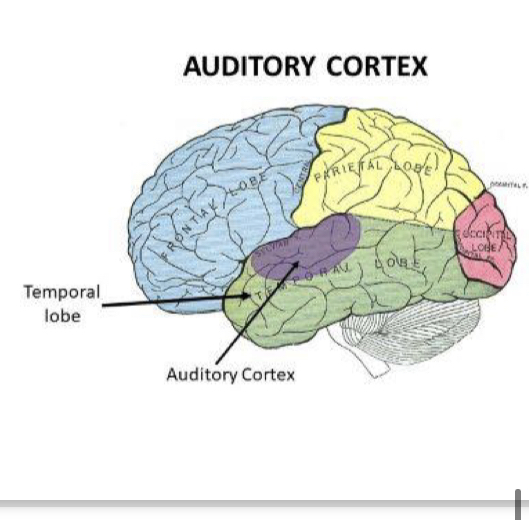
Frequency theory
– Different sound frequencies are converted into
different rates of action potentials
– High-frequency sounds produce a more rapid firing than do low-frequency sounds
Place theory
– Differences in sound frequency activate different
regions of the basilar membrane
– The brain equates the place activity occurred on the basilar membrane with a particular frequency
Absolute pitch ( what is it)
• • • •
Absolute Pitch
The ability to recognize or produce any note on a musical scale. Western countries – approximately 1 in 10,000 people have it It develops between 3 and 6 years of age
Those who speak tonal languages (Mandarin Chinese) are more likely to have absolute pitch.
Sound adaptation (what is it)
• The muscles around our ears can contract so less of the sound wave enters the ear
• Our ears become less sensitive to continuous noises
• Our brains filter out sounds that are not important
• Cocktail party effect – the brain picks up on relevant sounds, even in a noisy environment
Sound localization
• General loudness – louder sounds seem closer
• Loudness in each ear – the ear closer to the sound
hears a louder noise than the ear farther from the sound
• Timing – sound waves will reach the ear closer to the source of the sound before they reach the ear farther away
Development of hearing
• Babies can hear before they are born
• Ability to recognize and respond appropriately to
sounds develops in the first few months after birth
• Infants prefer speech (especially mom’s) to non- speech
types of Hearing loss (2 of them) and treatment option
• Deafness – loss of hearing (partial or complete)
– Can be genetic, caused by infection, physical trauma (headphone use), exposure to toxins, high doses of common medications such as Aspirin
• Tinnitus – ringing in the ear
– Due to abnormalities in the ear
– One of every 200 people experiences tinnitus
Treatment:
• Medical devices that are implanted in the ear and are wired to the nerves that send sound information to the brain
– E.g. Cochlear implants
Process of light entering eye (how the eye works)
- Light enters the eye
• Muscles in the iris (coloured part of the eye) adjust pupil size to control the amount of light allowed in
• Muscles also change the shape of the lens to bring the object into focus
• The lens focuses the light on the retina, multi-layered sheet of nerve cells
• Photoreceptors (sensory receptor cells for vision called rods and cones) are located in the retina
• There are two classes of photoreceptors (rods and cones), which transduce the light waves into a neural impulse
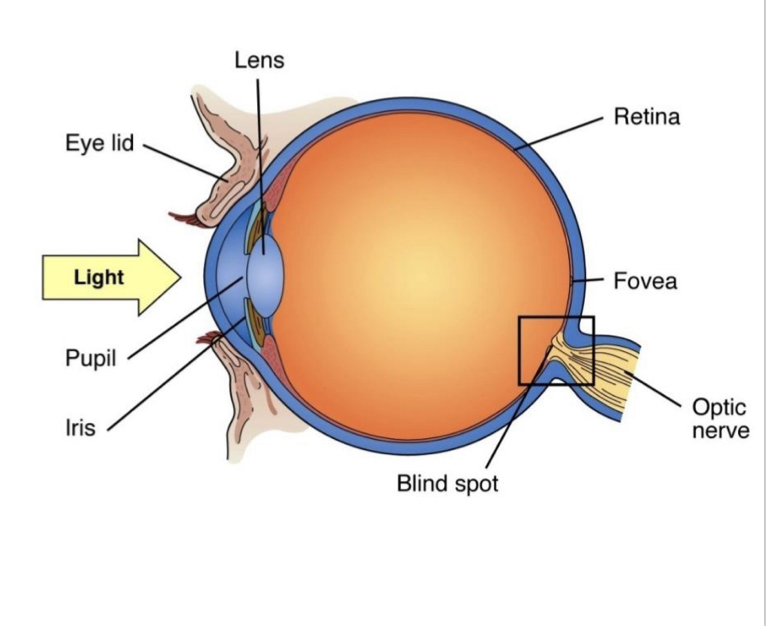
Rods what and purpose (retina)
• Detect light
• Used for periphery and night
vision
• Not as acute as cones (i.e., fuzzy vision)
• Many more rods than cones (over 100 million)
What are cones and purpose of cones (retina)
• Used for central and colour vision
• Very acute (i.e., very clear)
o The fovea (centre of retina) contains all cones
• Not as many cones (4.5 to 6 million)
Hue
the experience of colour based on the wavelength of light; green, blue, red, and other colours
Saturation
purity of color; how bright or vivid it is
Brightness
how much light is reflected from the object
Theories for seeing colour
no one theory explains everything for colour
Trichromatic theory
3 different sensors for colour and each type responds to a different range of wavelength of light
We see more than three colours, which is the variety of colours arise from combining the three colours.
Opponent process theory
colour pairs work to inhibit one another in the perception of colour
– Retinal ganglion cells are arranged in opposing cells: red-green, yellow-blue, black-white
– Support for this theory – we cannot see mixes of certain colors: reddish green or bluish yellow
Trichromatic theory
there are three different sensors for colour and each type responds to a different range of wavelengths of light
– We see more than three colours, which is the variety of colours arise from combining the three colours.
Opponent process theory
– colour pairs work to inhibit one another in the perception of colour
– Retinal ganglion cells are arranged in opposing cells: red-green, yellow-blue, black-white
– Support for this theory – we cannot see mixes of certain colors: reddish green or bluish yellow
Colour blindness
• Not really blind to colour, just can’t see the same range of colours as others
• Most people who are colour blind cannot distinguish between red and green.
• Could be due to shortage of cones in the red/green range
Visual fields (where does the optic nerve Carrie’s messages from each eye to?)
The optic nerve carries messages from each eye (visual field) to the visual cortex (occipital lobe).

Visual pathway
• The optic nerve contains the axons of 1 million ganglion cells that exit the eye via the blind spot and project to the thalamus
• From the thalamus, neurons project to the visual cortex
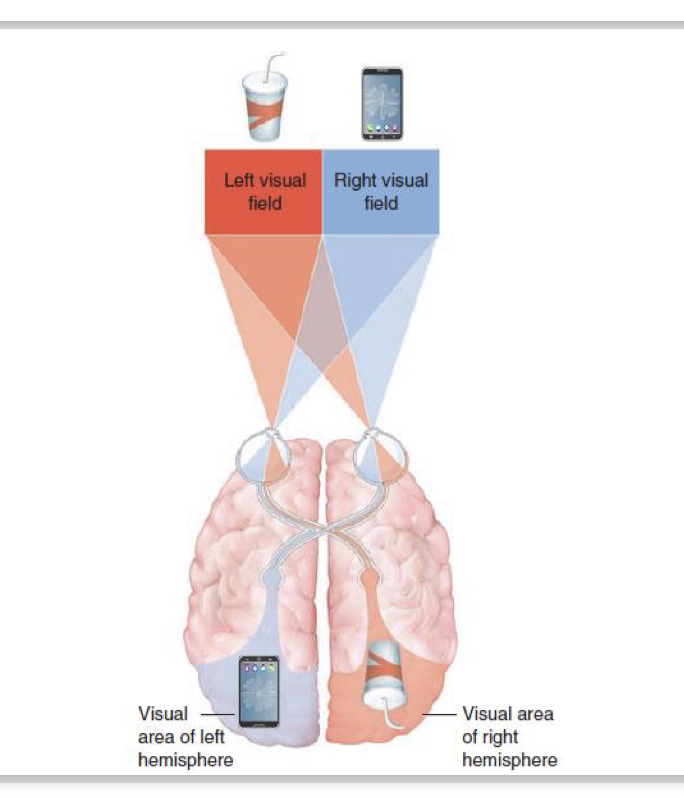
“What” pathway. (What it is and what are the 2 diseases associated with this)
• Helps us determine the identity of an object
• Visual agnosia – damage to the “what” pathway; cannot visually recognize objects
• Prosopagnosia – a form of visual agnosia in which people cannot recognize faces
“Where” pathway (what is it and the disease associated with it)
locates objects in space
Hemi-neglect – damage to the “where” pathway; people ignore one side of their visual field
• Example: eat food on only one side of plate
• People with damage to the right side of their “where” pathways neglect the left side of their visual field
Gestalt’s 5 (top down processing) laws
Proximity: Objects that are physically close together are grouped together.
Similarity: Similar objects are grouped together
Continuity: Objects that continue a pattern are grouped together
Closure: We fill in small gaps in objects so that they are perceived as whole objects
Figure ground:The tendency to perceive one aspect as the figure and the other one as the background
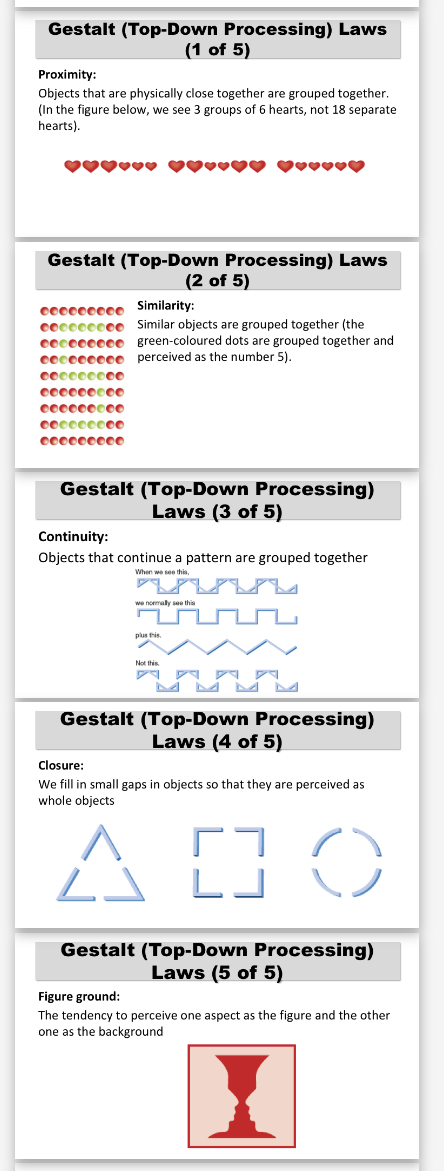
Depth perception (what contributes to it)
• Binocular cues – cues from both eyes
• Retinal disparity – different images of objects are cast
on the retinas of each eye
• Convergence – the tendency of the eyes to move toward each other as we focus on objects up close
Relative height (elevation) (monocular Cues-cues from one eye)
we see objects that are higher in our visual plane as farther away than those that are lower

Texture gradient (monocular cues)
we can see more details of textured surfaces, such as the wood grain on a restaurant table, that are closer to us

Relative size (monocular cues)
when we look at two objects we know are about the same size, if one seems smaller than the other, we see it as farther away than the other
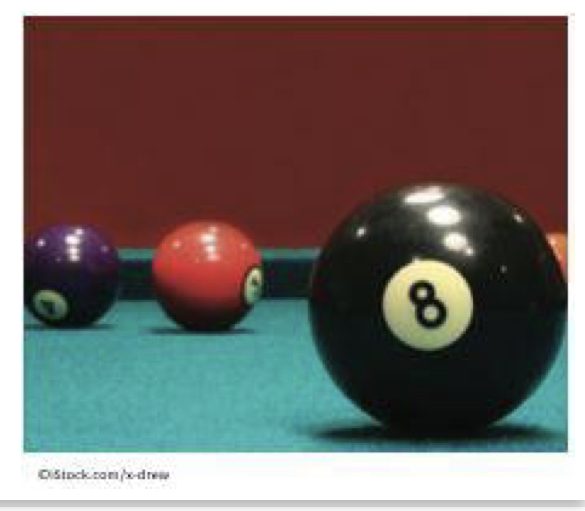
Linear perspective (monocular cues)
parallel lines seem to converge in the distance
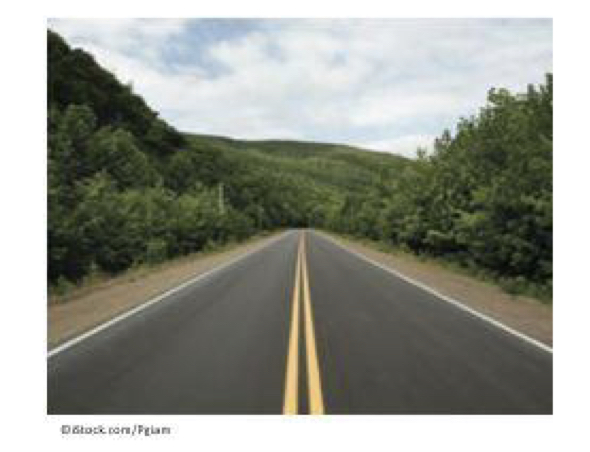
All 4 monocular cues
Relative height (elevation) – we see objects that are higher in our visual plane as farther away than those that are lower
Texture gradient – we can see more details of textured surfaces, such as the wood grain on a restaurant table, that are closer to us
Relative size – when we look at two objects we know are about the same size, if one seems smaller than the other, we see it as farther away than the other
Linear perspective – parallel lines seem to converge in the distance
Muller lyer illusion
The line on the right appears longer, but both lines are the same length.

Ponzo illusion
The converging lines make the upper bar seem larger, but both bars are identical in length.
Perceptual constancies (shape and size)
• Perceptual constancy – our top-down tendency to view objects as unchanging, despite shifts in the environmental stimuli we receive
• Size constancy – we perceive objects as the same size, regardless of the distance from which it is viewed
• Shape constancy – we see an object as the same shape, no matter from what angle it is viewed
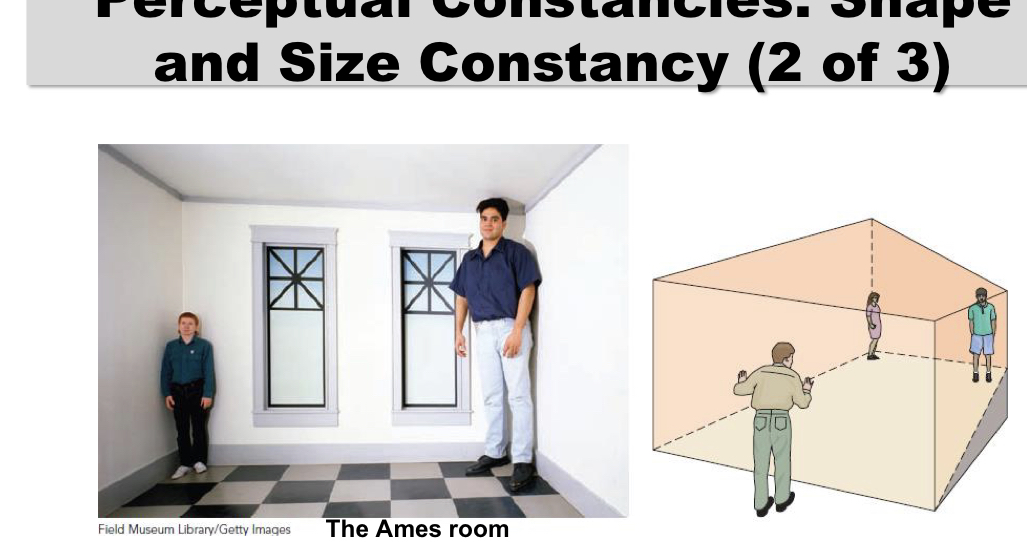
Development of sight
• Newborns can see, but their vision will improve significantly by two months of age
• At eight months of age, visual acuity is similar to adults
• Experience with the visual world is necessary for normal visual system development
The 2 Visual impairment and loss problems as well as the solution to these problems
• Strabismus – lack of coordinated movement of both eyes; affects about 2%−4% of the population
• Amblyopia – a loss of visual abilities in a weaker eye; abnormal development of the brain’s visual cortex due to a failure to receive coordinated visual stimulation from both eyes by the age of six
About half a million people in Canada have visual impairments
• Each year, 50,000 Canadians lose their sight • How do people adapt to visual impairments?
– Braille – a form of reading skill used by individuals suffering from visual impairments
Kinesthetic
receptor cells in your muscles tell the brain when we are moving and where our body parts are in space
Vestibular
located in the semicircular canals of our inner ears; the movement of fluid tells us if we are standing up or swaying from side to side
Learning
lasting change caused by experience; it has to be inferred from behaviour and cannot be directly observed
2 types of learning
• Associative learning – a change as a result of experience where two or more stimuli become linked
• Non-associative learning – learning that does not involve forming associations between stimuli; learning occurs following repeated exposure to a single stimulus or event
non associative learning
• Habituation – weakening of response to a stimulus after
repeated presentation
– Different than neuron fatigue that happens during sensory
adaptation
– e.g. A bird becoming accustomed to a human’s presence over time • Dishabituation – there is a recovery of attention to a novel
stimulus following habitation
– E.g. A bird becomes anxious when someone new is present
• Sensitization – a strong stimulus results in an exaggerated
response to the subsequent presentation of weaker stimuli
– E.g. unexpected noise startles you, and you become more responsive
to other weaker stimuli that follow (e.g. cell phone buzz, wind rattling windows, etc.)
Associative learning and it’s types
Associative learning – connections are formed between two or more stimuli; accounts for most learning
Types of associative learning:
• Classical conditioning
• Operant conditioning
Classical conditioning
a form of associative learning between two previously unrelated stimuli that results in a learned response
Discovered by Ivan pavlov
Pavlov’s dog experiment setup
Pavlov’s experiment for collecting and measuring salivation in dogs – The hungry dog is placed in a harness and given a bowl of meat powder. A tube from the salivary gland collects the saliva, which is measured and recorded.
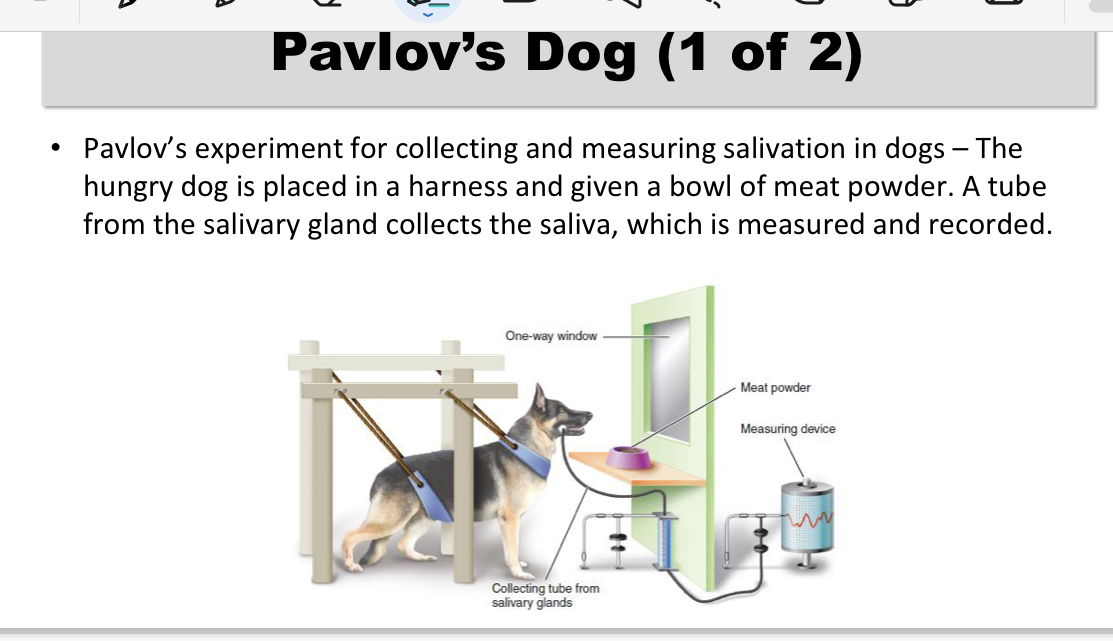
Conditioning
the association of events in the environment
Unconditional stimulus (classical conditioning)
Unconditioned stimulus (US) – a stimulus that on its own elicits a response (i.e., food)
Unconditional response (classical conditioning)
Unconditioned response (UR) - a physical response elicited by an unconditioned stimulus; it does not need to be learned (i.e., salivation)
Conditioned stimulus (classical conditioning)
a neutral stimulus that eventually elicits the same response as an unconditioned stimulus with which it has been paired (i.e., bell)
Conditioned response
a physical response elicited by a conditioned stimulus; it is acquired through experience and is usually the same as the unconditioned response (i.e., salivation)
The mechanism of Pavlov’s dog experiment

Acquisition (process of classical conditioning)
Acquisition - the initial learning of the stimulus- response relationship
– The more pairings between the CS and US, the more likely the association will be learned
– The most rapid acquisition followed by the strongest response is a half-second delay between the CS and US
Extinction ( process of classical conditioning)
reduction of a conditioned response after repeated presentations of the conditioned stimulus alone
Spontaneous recovery ( process of classical conditioning)
re-emergence of a conditioned response some time after extinction has occurred
Stimulus generalization (process of classical conditioning)
what occurs when stimuli similar to
the original conditioned stimulus trigger the same conditioned
response.
– E.g. people who are afraid of snakes are usually afraid of all snakes,
not just the specific type of snake to which they first felt fear
Stimulus discrimination (process of classical conditioning)
what occurs when an organism learns to emit a specific behaviour in the presence of a conditioned stimulus, but not in the presence of stimuli similar to the conditioned
stimulus
– E.g. learning to distinguish between snakes; learning to distinguish
between different but similar tones/sounds
Higher order conditioning (process of classical conditioning)
what occurs when a previously- conditioned stimulus functions as if it were an unconditioned stimulus for further conditioning
– E.g. If Pavlov started pairing music with the bell and then music started to lead to salivating
Classical conditioning and fear experiment by Watson
Used a white rat and loud noise to illicit fear in a person
